Effect of Reduced Graphene Oxide on Microwave Absorbing Properties of Al1.5Co4Fe2Cr High-Entropy Alloys
Abstract
1. Introduction
2. Materials and Methods
3. Results and Discussion
3.1. Microstructure of Al1.5Co4Fe2Cr and Al1.5Co4Fe2Cr@rGO HEA Powders
3.2. Magnetic Properties
3.3. Electromagnetic Parameters
3.4. Electromagnetic Wave Absorption Performance
4. Conclusions
Author Contributions
Funding
Institutional Review Board Statement
Data Availability Statement
Conflicts of Interest
References
- Zhao, Y.; Ji, G.B. Multi-spectrum bands compatibility: New trends in stealth materials research. Sci. China Mater. 2022, 65, 2936–2941. [Google Scholar] [CrossRef]
- Zou, T.C.; Wu, Y.B.; Li, H.P. Electromagnetic and microwave absorbing properties of carbon-encapsulated cobalt nanoparticles. Mater. Lett. 2018, 214, 280–282. [Google Scholar] [CrossRef]
- Ahmad, H.; Tariq, A.; Shehzad, A.; Faheem, M.S.; Shafiq, M.; Rashid, I.A.; Afzal, A.; Munir, A.; Riaz, M.T.; Haider, H.T. Stealth technology: Methods and composite materials—A review. Polym. Compos. 2019, 40, 4457–4472. [Google Scholar] [CrossRef]
- Yin, L.X.; Doyhamboure, J.; Tian, X.Y.; Li, D.C. Design and characterization of radar absorbing structure based on gradient-refractive-index metamaterials. Compos. Part B Eng. 2018, 132, 178–187. [Google Scholar] [CrossRef]
- Wang, B.X.; Xu, C.Y.; Duan, G.Y.; Xu, W.; Pi, F.W. Review of Broadband Metamaterial Absorbers: From Principles, Design Strategies, and Tunable Properties to Functional Applications. Adv. Funct. Mater. 2023, 33, 2213818. [Google Scholar] [CrossRef]
- Zeng, X.J.; Cheng, X.Y.; Yu, R.H.; Stucky, G.D. Electromagnetic microwave absorption theory and recent achievements in microwave absorbers. Carbon 2020, 168, 606–623. [Google Scholar] [CrossRef]
- Zhang, K.C.; Zhang, Q.; Gao, X.B.; Chen, X.F.; Wang, Y.; Li, W.C.; Wu, J.Y. Effect of absorbers’ composition on the microwave absorbing performance of hollow Fe3O4 nanoparticles decorated CNTs/graphene/C composites. J. Alloys Compd. 2018, 748, 706–716. [Google Scholar] [CrossRef]
- Jiao, Z.G.; Ma, M.L.; Bi, Y.X.; Lu, C.G.; Feng, C.; Lyu, P.; Zhao, J.D.; Ma, Y. A review of carbon-based magnetic microwave-absorbing composites with one-dimensional structure. J. Mater. Sci. 2022, 57, 18243–18265. [Google Scholar] [CrossRef]
- Wang, C.; Han, X.J.; Xu, P.; Zhang, X.L.; Du, Y.C.; Hu, S.R.; Wang, J.Y.; Wang, X.H. The electromagnetic property of chemically reduced graphene oxide and its application as microwave absorbing material. Appl. Phys. Lett. 2011, 98, 072906. [Google Scholar] [CrossRef]
- Zhang, Y.; Huang, Y.; Zhang, T.Z.; Chang, H.C.; Xiao, P.S.; Chen, H.H.; Huang, Z.Y.; Chen, Y.S. Broadband and tunable high-performance microwave absorption of an ultralight and highly compressible graphene foam. Adv. Mater. 2015, 27, 2049–2053. [Google Scholar] [CrossRef] [PubMed]
- Ren, Y.L.; Wu, H.Y.; Lu, M.M.; Chen, Y.J.; Zhu, C.L.; Gao, P.; Cao, M.S.; Li, C.Y.; Ouyang, Q.Y. Quaternary nanocomposites consisting of graphene, Fe3O4@Fe, and ZnO nanoparticles: Synthesis and excellent electromagnetic absorption properties. ACS Appl. Mater. Interfaces 2012, 4, 6436–6442. [Google Scholar] [CrossRef] [PubMed]
- Chen, C.C.; Liang, W.F.; Nien, Y.H.; Liu, H.K.; Yang, R.B. Microwave absorbing properties of flake-shaped carbonyl iron/reduced graphene oxide/epoxy composites. Mater. Res. Bull. 2017, 96, 81–85. [Google Scholar] [CrossRef]
- Liu, P.J.; Yao, Z.J.; Hong, N.V.M.; Zhou, J.T.; Yang, Z.H.; Kong, L.B. Enhanced Microwave Absorption Properties of Double-Layer Absorbers Based on Spherical NiO and Co0.2Ni0.4Zn0.4Fe2O4 Ferrite Composites. Acta Metall. Sin. 2018, 31, 171–179. [Google Scholar] [CrossRef]
- Ding, G.X.; Chen, C.X.; Tai, H.X.; Tang, Z.H.; Wang, Z.F.; Cheng, G.J.; Wan, X.L. Structural characterization and microwave absorbing performance of CuFe2O4@rGO composites. J. Solid State Chem. 2021, 297, 122051. [Google Scholar] [CrossRef]
- Olejarz, A.; Huo, W.Y.; Zieliński, M.; Diduszko, R.; Wyszkowska, E.; Kosińska, A.; Kalita, D.; Jóźwik, I.; Chmielewski, M.; Fang, F.; et al. Microstructure and mechanical properties of mechanically-alloyed CoCrFeNi high-entropy alloys using low ball-to-powder ratio. J. Alloys Compd. 2023, 938, 168196. [Google Scholar] [CrossRef]
- Duan, Y.P.; Cui, Y.L.; Zhang, B.; Guo, M.J.; Wang, T.M. FeCoNiCuAl high entropy alloys microwave absorbing materials: Exploring the effects of different Cu contents and annealing temperatures on electromagnetic properties. J. Alloys Compd. 2020, 848, 156491. [Google Scholar] [CrossRef]
- Zhang, B.; Duan, Y.P.; Cui, Y.L.; Ma, G.J.; Wang, T.M.; Dong, X.L. A new mechanism for improving electromagnetic properties based on tunable crystallographic structures of FeCoNiSixAl0.4 high entropy alloy powders. RSC Adv. 2018, 8, 14936–14946. [Google Scholar] [CrossRef] [PubMed]
- Yang, J.P.; Jiang, L.W.; Liu, Z.H.; Tang, Z.; Wu, A.H. Multifunctional interstitial-carbon-doped FeCoNiCu high entropy alloys with excellent electromagnetic-wave absorption performance. J. Mater. Sci. Technol. 2022, 113, 61–70. [Google Scholar] [CrossRef]
- Ma, Y.; Wang, Q.; Zhou, X.Y.; Hao, J.M.; Gault, B.; Zhang, Q.Y.; Dong, C.; Nieh, T.G. A Novel Soft-Magnetic B2-Based Multi principal-Element Alloy with a Uniform Distribution of Coherent Body-Centered-Cubic Nanoprecipitates. Adv. Mater. 2021, 33, e2006723. [Google Scholar] [CrossRef] [PubMed]
- Tan, X.H.; Tang, Y.J.; Tan, Y.F.; Deng, Q.; Jiao, H.S.; Yang, Y.; Xu, H. Correlation between microstructure and soft magnetic parameters of Fe-Co-Ni-Al medium-entropy alloys with FCC phase and BCC phase. Intermetallics 2020, 126, 106898. [Google Scholar] [CrossRef]
- Zhang, B.; Duan, Y.P.; Cui, Y.L.; Ma, G.J.; Wang, T.M.; Dong, X.L. Improving electromagnetic properties of FeCoNiSi0.4Al0.4 high entropy alloy powders via their tunable aspect ratio and elemental uniformity. Mater. Des. 2018, 149, 173–183. [Google Scholar] [CrossRef]
- Gao, M.M.; Zhao, Y.; Wang, S.S.; Xu, Y.C.; Feng, C.H.; Shi, D.X.; Jiao, Q.Z. Preparation of pod-like 3D Ni0.33Co0.67Fe2O4@rGO composites and their microwave absorbing properties. Ceram. Int. 2019, 45, 7188–7195. [Google Scholar] [CrossRef]
- Kuang, B.Y.; Song, W.L.; Ning, M.Q.; Li, J.B.; Zhao, Z.J.; Guo, D.Y.; Cao, M.S.; Jin, H.B. Chemical reduction dependent dielectric properties and dielectric loss mechanism of reduced graphene oxide. Carbon 2018, 127, 209–217. [Google Scholar] [CrossRef]
- Liu, X.J.; Duan, Y.P.; Li, Z.R.; Pang, H.F.; Huang, L.X.; Yang, X.; Shi, Y.P.; Wang, T.M.; Lv, X.J. FeCoNiCr0.4Cux High-Entropy Alloys with Strong Intergranular Magnetic Coupling for Stable Megahertz Electromagnetic Absorption in a Wide Temperature Spectrum. ACS Appl. Mater. Interfaces 2022, 14, 7012–7021. [Google Scholar] [CrossRef] [PubMed]
- Liu, X.J.; Duan, Y.P.; Yang, X.; Huang, L.X.; Gao, M.M.; Wang, T.M. Enhancement of magnetic properties in FeCoNiCr0.4Cux high entropy alloys through the cocktail effect for megahertz electromagnetic wave absorption. J. Alloys Compd. 2021, 872, 159602. [Google Scholar] [CrossRef]
- Duan, Y.P.; Gao, M.M.; Pang, H.F.; Wang, T.M. FeCoNiMnAl high-entropy alloy: Improving electromagnetic wave absorption properties. J. Mater. Res. 2021, 36, 2107–2117. [Google Scholar] [CrossRef]
- Duan, Y.P.; Wen, X.; Zhang, B.; Ma, G.J.; Wang, T.M. Optimizing the electromagnetic properties of the FeCoNiAlCrx high entropy alloy powders by composition adjustment and annealing treatment. J. Magn. Magn. Mater. 2020, 497, 165947. [Google Scholar] [CrossRef]
- Wani, I.S.; Bhattacharjee, T.; Sheikh, S.; Lu, Y.P.; Chatterjee, S.; Bhattacharjee, P.P.; Guo, S.; Tsuji, N. Ultrafine-grained AlCoCrFeNi2.1 eutectic high-entropy alloy. Mater. Res. Lett. 2016, 4, 174–179. [Google Scholar] [CrossRef]
- Zhao, B.; Fan, B.B.; Shao, G.; Wang, B.B.; Pian, X.X.; Li, W.; Zhang, R. Investigation on the electromagnetic wave absorption properties of Ni chains synthesized by a facile solvothermal method. Appl. Surf. Sci. 2014, 307, 293–300. [Google Scholar] [CrossRef]
- Liu, B.; Wang, X.F.; Chen, H.T.; Wang, Z.R.; Chen, D.; Cheng, Y.B.; Zhou, C.G.; Shen, G.Z. Hierarchical silicon nanowires-carbon textiles matrix as a binder-free anode for high-performance advanced lithium-ion batteries. Sci. Rep. 2013, 3, 1622. [Google Scholar] [CrossRef]
- Zhang, X.F.; Liu, Y.Y.; Qin, G.W. Break Snoek limit via superparamagnetic coupling in Fe3O4/silica multiple-core/shell nanoparticles. Appl. Phys. Lett. 2015, 106, 033105. [Google Scholar] [CrossRef]
- Liu, J.K.; Jia, Z.R.; Zhou, W.H.; Liu, X.H.; Zhang, C.H.; Xu, B.H.; Wu, G.L. Self-assembled MoS2/magnetic ferrite CuFe2O4 nanocomposite for high-efficiency microwave absorption. Chem. Eng. J. 2022, 429, 132253. [Google Scholar] [CrossRef]
- Yi, P.S.; Yao, Z.J.; Zhou, J.T.; Wei, B.; Lei, L.; Tan, R.Y.; Fan, H.Y. Facile synthesis of 3D Ni@C nanocomposites derived from two kinds of petal-like Ni-based MOFs towards lightweight and efficient microwave absorbers. Nanoscale 2021, 13, 3119–3135. [Google Scholar] [CrossRef] [PubMed]
- Zhang, M.M.; Jiang, Z.Y.; Lv, X.Y.; Zhang, X.F.; Zhang, Y.H.; Zhang, J.W.; Zhang, L.; Gong, C.H. Microwave absorption performance of reduced graphene oxide with negative imaginary permeability. J. Phys. D Appl. Phys. 2019, 53, 02LT01. [Google Scholar] [CrossRef]
- Wang, J.W.; Wang, B.B.; Wang, Z.; Chen, L.; Gao, C.H.; Xu, B.H.; Jia, Z.R.; Wu, G.L. Synthesis of 3D flower-like ZnO/ZnCo2O4 composites with the heterogeneous interface for excellent electromagnetic wave absorption properties. J. Colloid Interface Sci. 2021, 586, 479–490. [Google Scholar] [CrossRef]
- Yang, J.; Zhang, J.; Liang, C.Y.; Wang, M.; Zhao, P.F.; Liu, M.M.; Liu, J.W.; Che, R.C. Ultrathin BaTiO3 nanowires with high aspect ratio: A simple one-step hydrothermal synthesis and their strong microwave absorption. ACS Appl. Mater. Interfaces 2013, 5, 7146–7151. [Google Scholar] [CrossRef]
- Wang, C.; Han, X.J.; Xu, P.; Wang, J.Y.; Du, Y.C.; Wang, X.H.; Qin, W.; Zhang, T. Controlled synthesis of hierarchical nickel and morphology-dependent electromagnetic properties. J. Phys. Chem. C 2010, 114, 3196–3203. [Google Scholar] [CrossRef]
- He, G.H.; Duan, Y.P.; Pang, H.F.; Zhang, X.F. Rational design of mesoporous MnO2 microwave absorber with tunable microwave frequency response. Appl. Surf. Sci. 2019, 490, 372–382. [Google Scholar] [CrossRef]
- Wanasinghe, D.; Aslani, F. A review on recent advancement of electromagnetic interference shielding novel metallic materials and processes. Compos. Part B Eng. 2019, 176, 107207. [Google Scholar] [CrossRef]
- Ji, Z.Y.; Wang, Q.; Wang, Z.H.; Duan, Y.P.; Dong, C.; Liaw, P.K. Electromagnetic wave-absorbing behavior of soft-magnetic medium entropy alloys with BCC/L21 coherent microstructure. Mater. Des. 2022, 222, 111054. [Google Scholar] [CrossRef]
- Duan, Y.P.; Pang, H.F.; Wen, X.; Zhang, X.F.; Wang, T.M. Microwave absorption performance of FeCoNiAlCr0.9 alloy powders by adjusting the amount of process control agent. J. Mater. Sci. Technol. 2021, 77, 209–216. [Google Scholar] [CrossRef]
- Wu, J.M.; Ye, Z.M.; Liu, W.X.; Liu, Z.F.; Chen, J. The effect of GO loading on electromagnetic wave absorption properties of Fe3O4/reduced graphene oxide hybrids. Ceram. Int. 2017, 43, 13146–13153. [Google Scholar] [CrossRef]
- Xiong, J.L.; Pan, S.K.; Cheng, L.C.; Liu, X.; Lin, P.H. Structure and microwave absorption properties of Pr–Fe–Ni alloys. J. Magn. Magn. Mater. 2015, 384, 106–112. [Google Scholar] [CrossRef]
- Xu, Z.X.; Xia, T.R.; Cheng, L.C.; Xiang, R.; Yao, Q.R.; Long, Q.X.; Lu, Z. Effect of Tb Doping Amount on Microwave Absorption Performance of Dy2Co17 Alloys. J. Electron. Mater. 2023, 52, 3132–3145. [Google Scholar] [CrossRef]
- Yang, P.P.; Liu, Y.; Zhao, X.C.; Cheng, J.W.; Li, H. Electromagnetic wave absorption properties of mechanically alloyed FeCoNiCrAl high entropy alloy powders. Adv. Powder Technol. 2016, 27, 1128–1133. [Google Scholar] [CrossRef]
- Yang, P.C.; Tian, C.; Yao, Q.R. Effects of Co Element on the Structure, Magnetic, and Microwave Absorption Properties of La-Fe-B Alloys. J. Supercond. Nov. Magn. 2019, 33, 1125–1128. [Google Scholar] [CrossRef]
- Zhang, Y.Z.; Chen, Y.D.; Qin, Q.D.; Li, W. Synthesis of FeCoNiCuZn single-phase high-entropy alloy by high-frequency electromagnetic-field assisted ball milling. J. Magn. Magn. Mater. 2020, 498, 166151. [Google Scholar]
- Tian, J.; Shi, H.Y.; Hu, H.Q.; Chen, B.; Bao, Y.F.; Tang, P. Implementation of atomically thick graphene and its derivatives in electromagnetic absorbers. Appl. Sci. 2019, 9, 388. [Google Scholar] [CrossRef]
- Huang, X.G.; Qiao, M.; Lu, X.C.; Li, Y.F.; Ma, Y.B.; Kang, B.; Quan, B.; Ji, G.B. Evolution of dielectric loss-dominated electromagnetic patterns in magnetic absorbers for enhanced microwave absorption performances. Nano Res. 2021, 14, 4006–4013. [Google Scholar] [CrossRef]
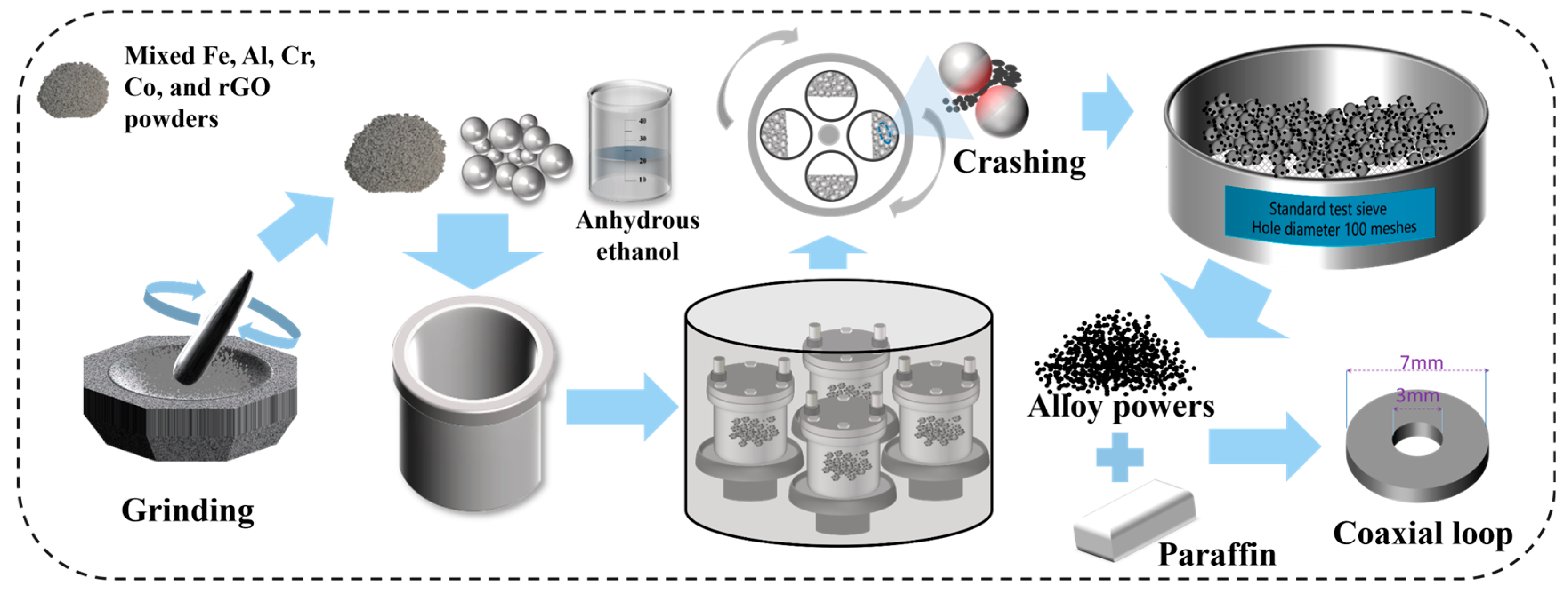

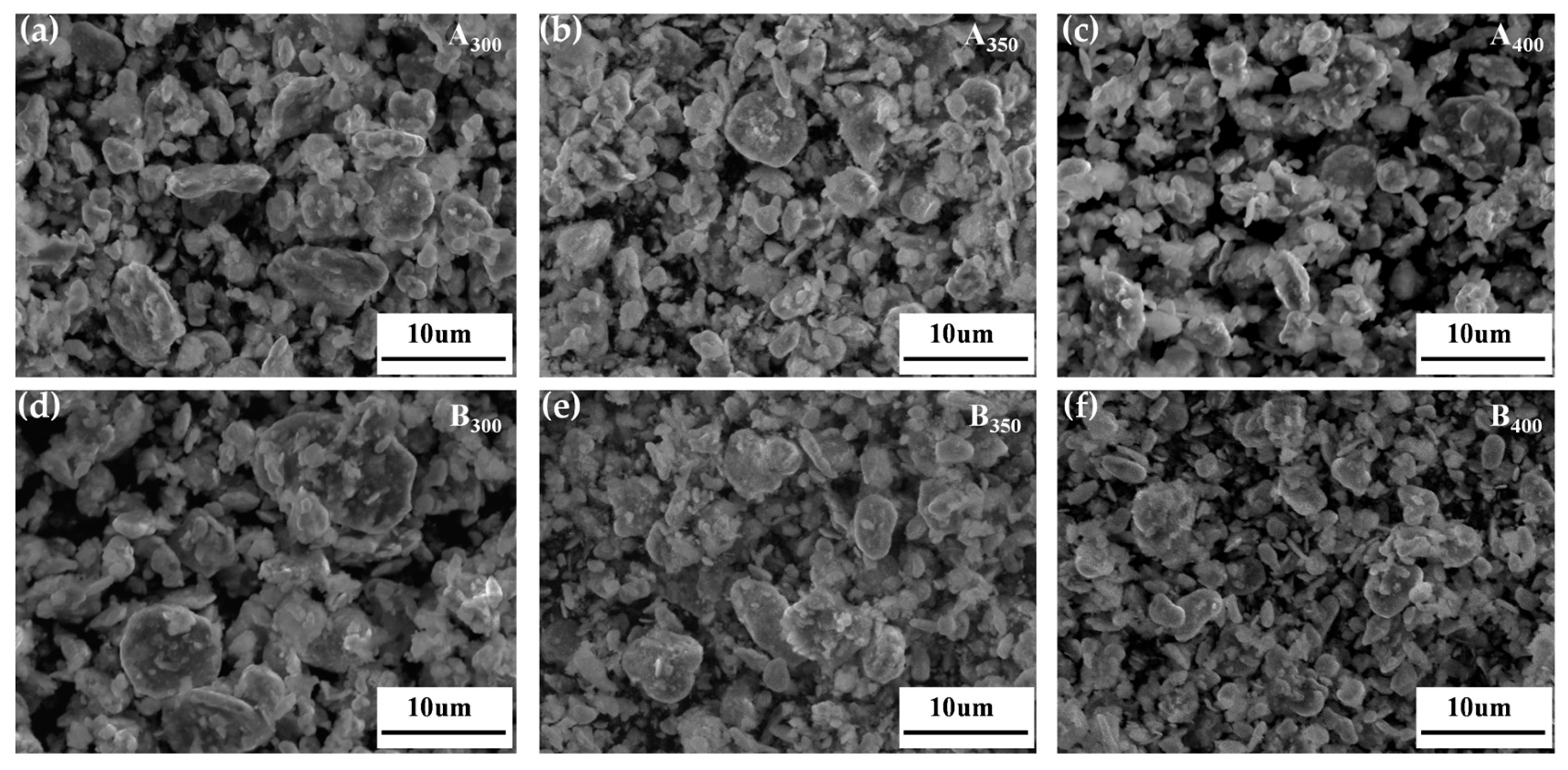
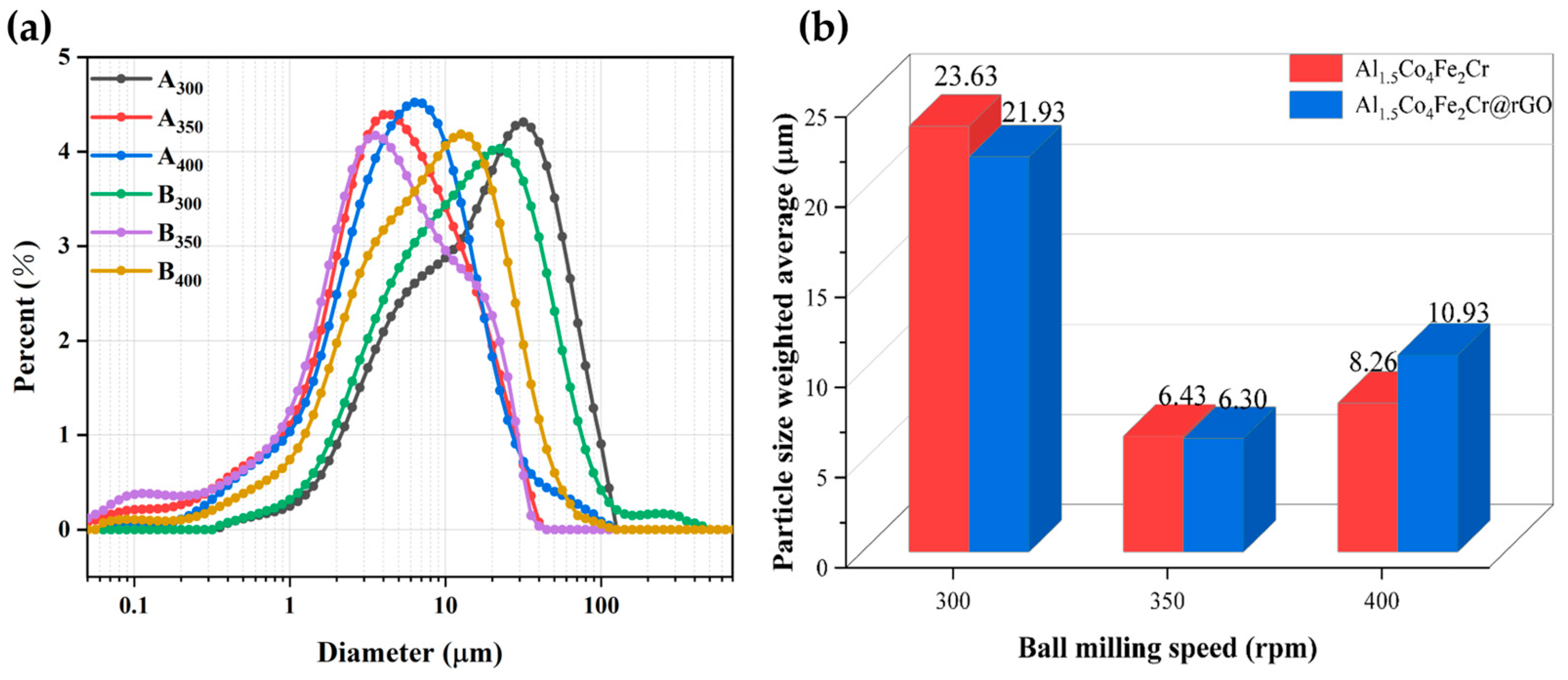
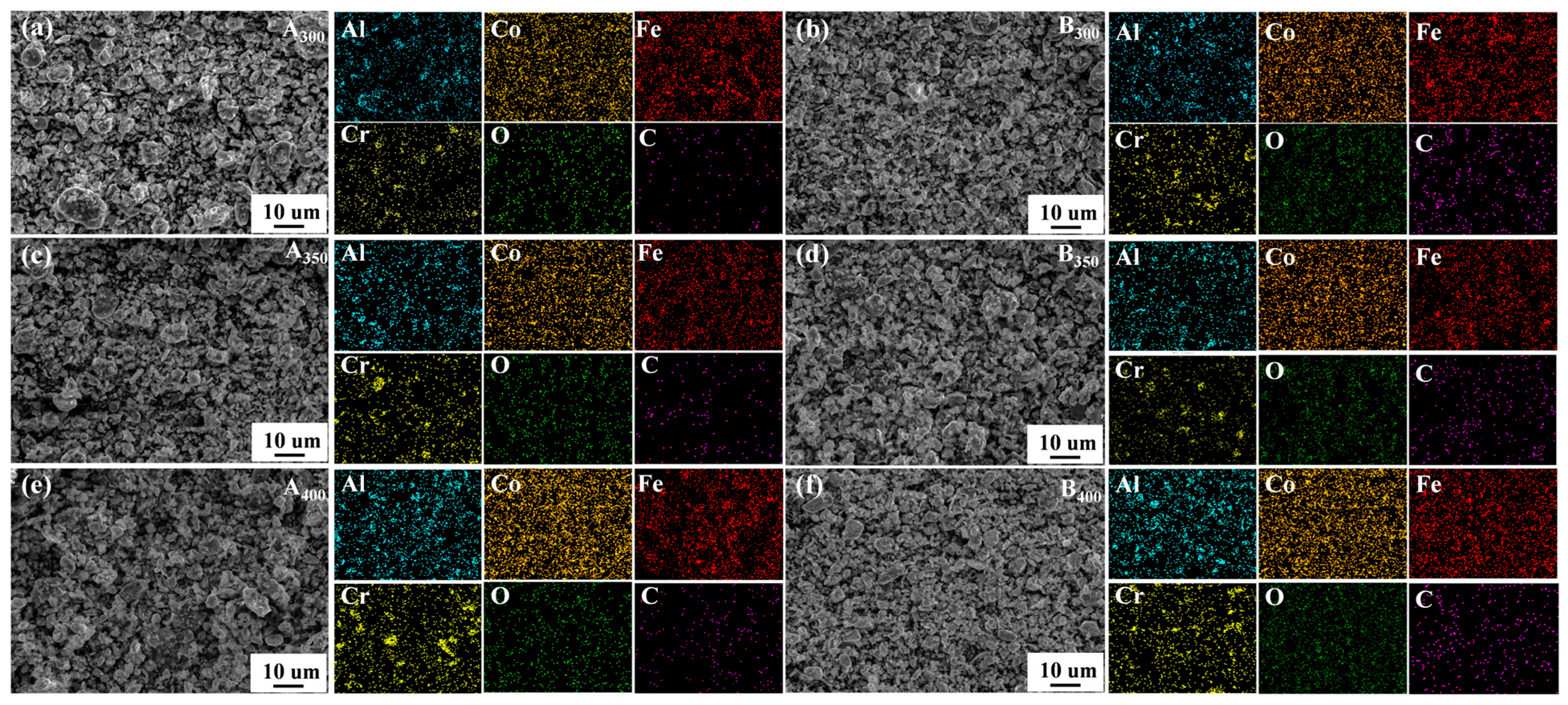
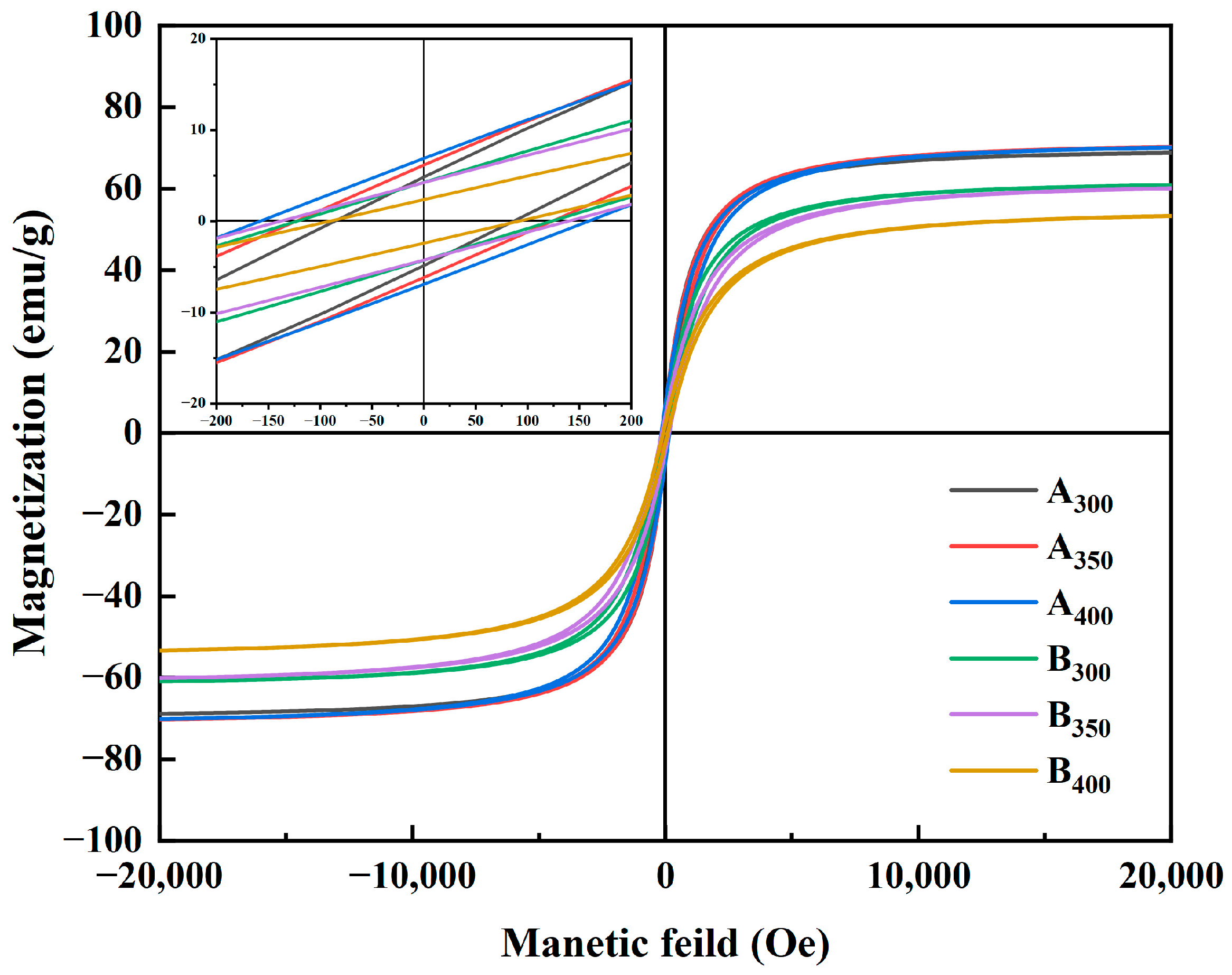
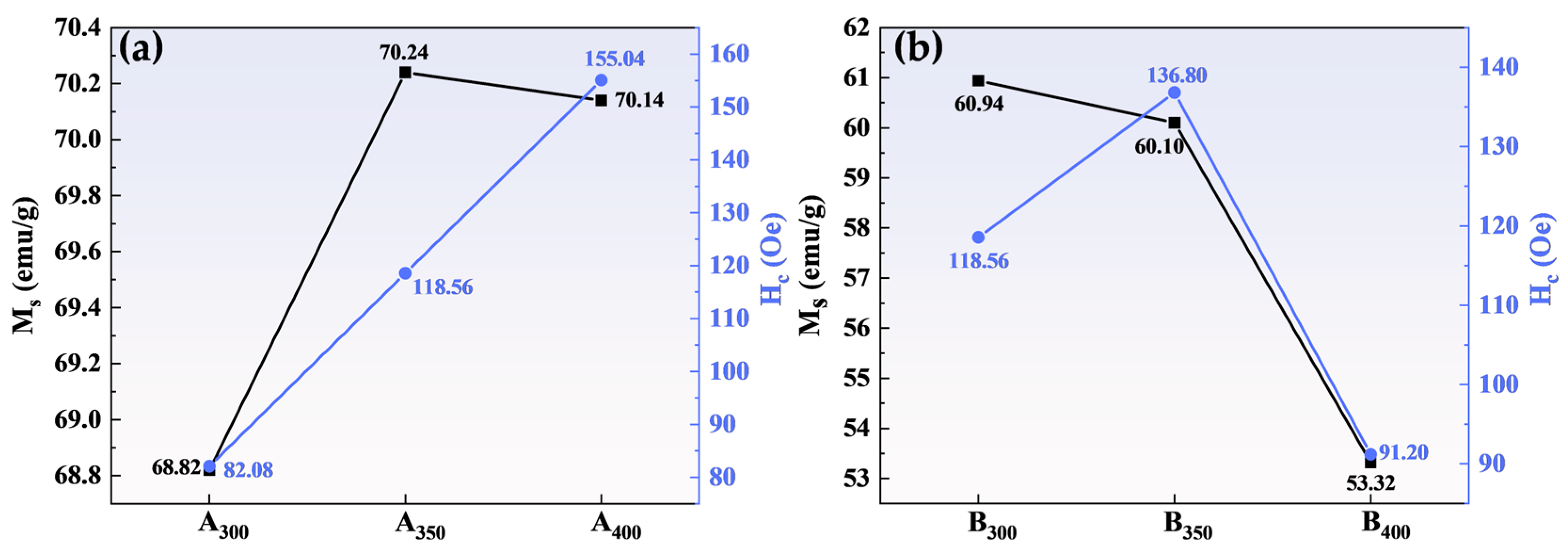
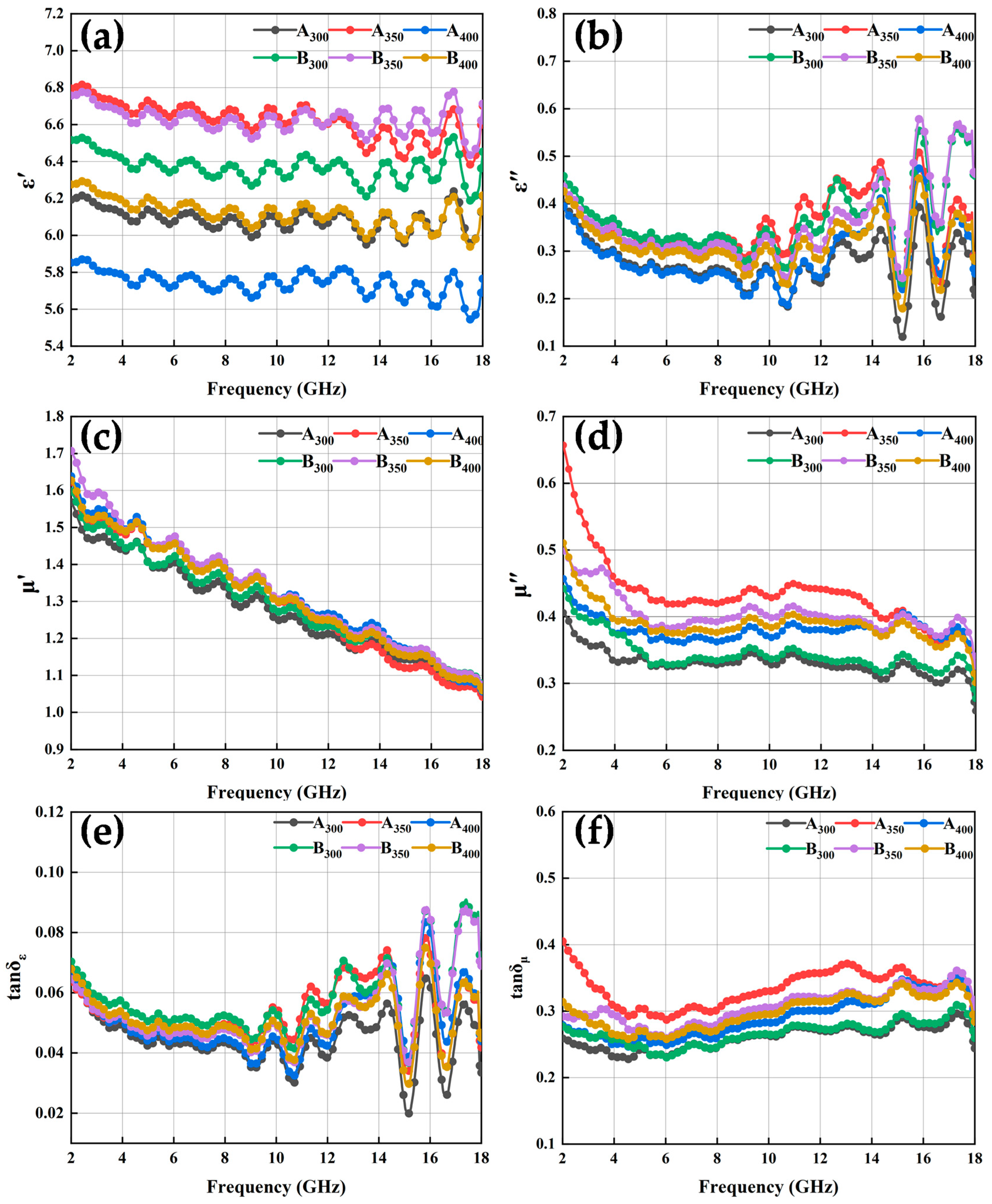
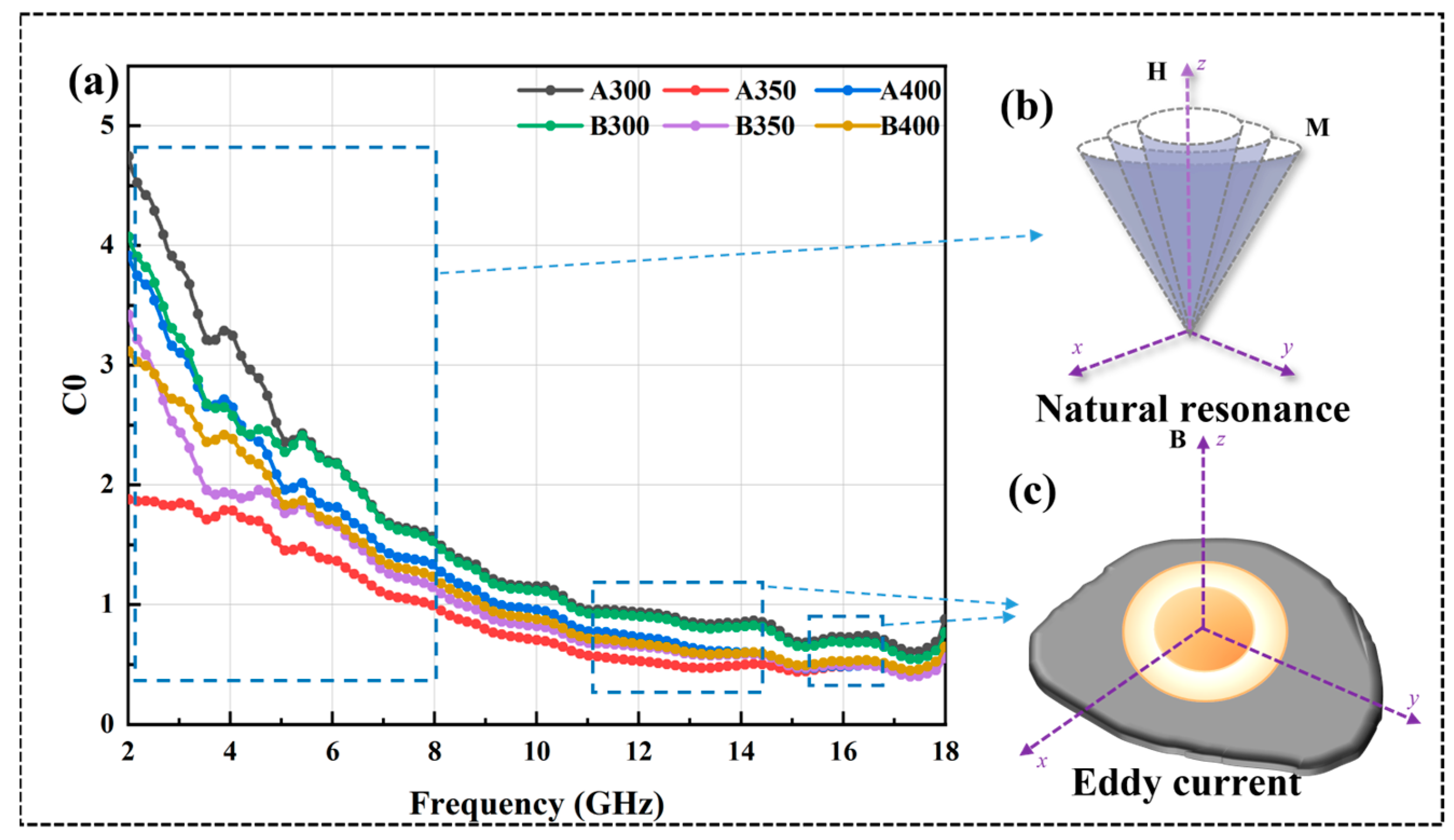
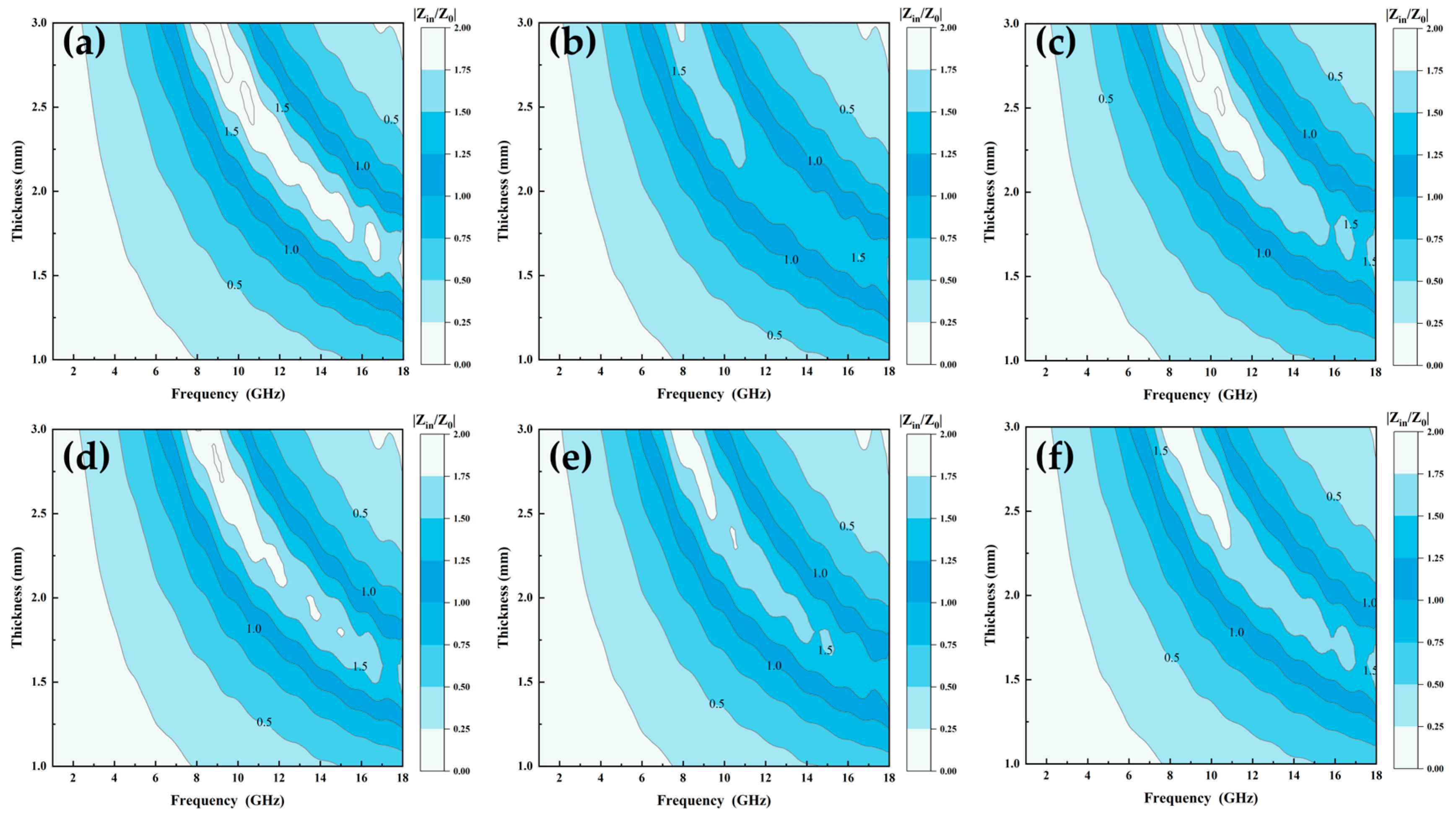
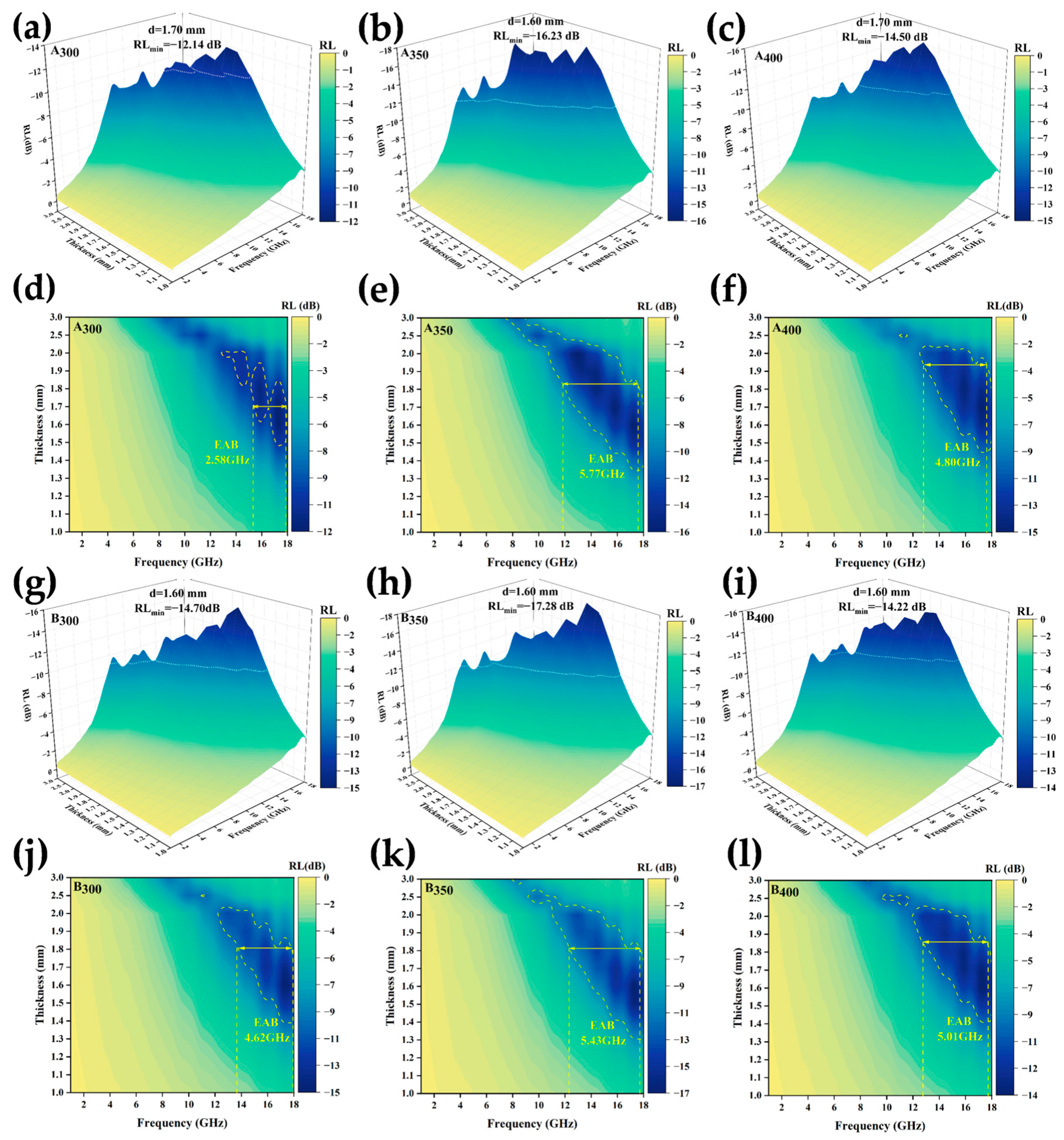
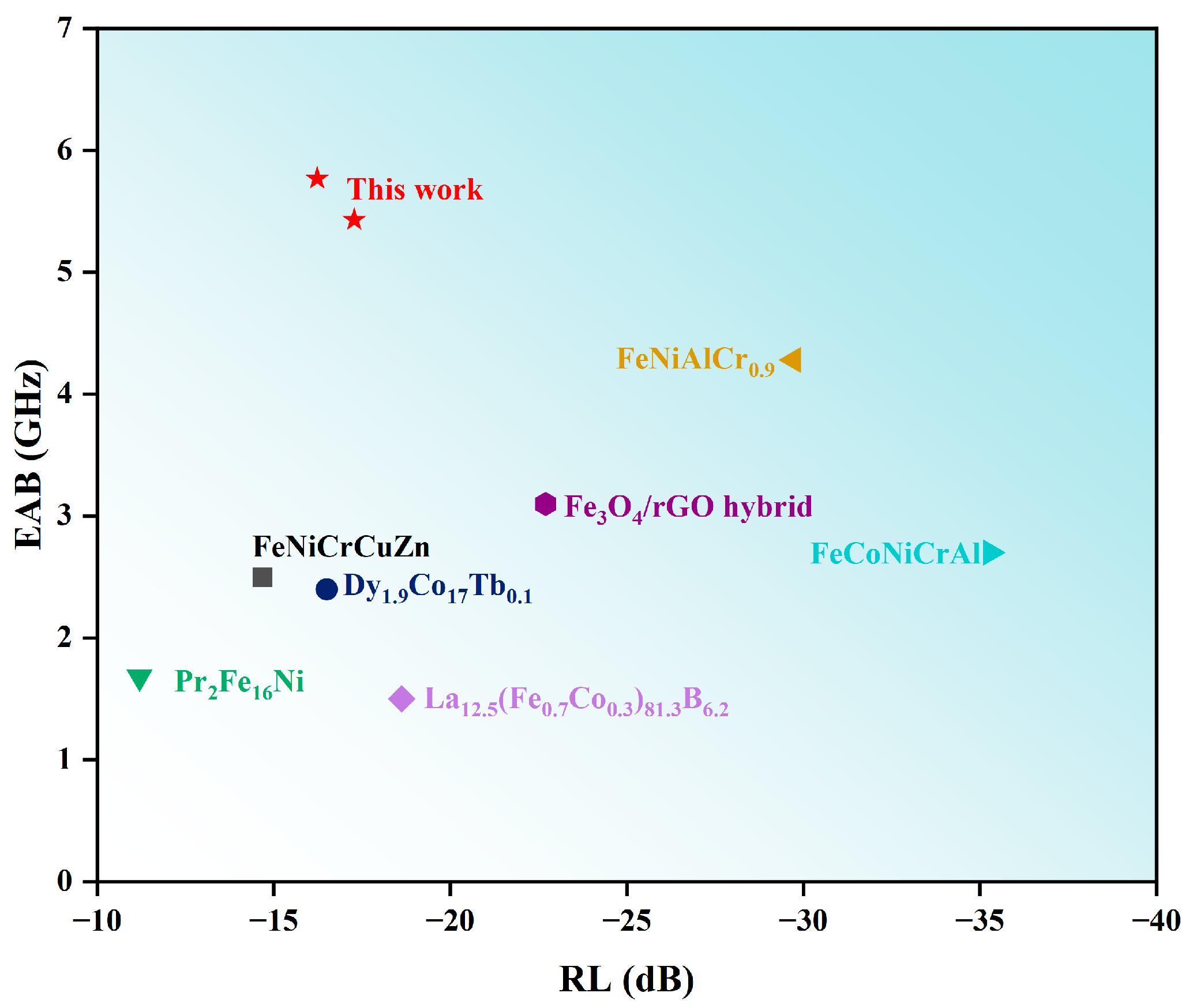

| Al | Co | Fe | Cr | C | O | |
|---|---|---|---|---|---|---|
| A300 | 8.28 | 50.98 | 24.96 | 12.40 | 1.36 | 2.02 |
| A350 | 7.94 | 51.32 | 25.03 | 11.39 | 1.89 | 2.43 |
| A400 | 7.21 | 49.26 | 26.21 | 12.68 | 2.04 | 2.60 |
| B300 | 7.86 | 48.57 | 25.44 | 12.75 | 2.81 | 2.57 |
| B350 | 8.43 | 50.20 | 24.09 | 11.96 | 2.97 | 2.35 |
| B400 | 7.57 | 49.54 | 26.33 | 10.88 | 2.85 | 2.83 |
Disclaimer/Publisher’s Note: The statements, opinions and data contained in all publications are solely those of the individual author(s) and contributor(s) and not of MDPI and/or the editor(s). MDPI and/or the editor(s) disclaim responsibility for any injury to people or property resulting from any ideas, methods, instructions or products referred to in the content. |
© 2024 by the authors. Licensee MDPI, Basel, Switzerland. This article is an open access article distributed under the terms and conditions of the Creative Commons Attribution (CC BY) license (https://creativecommons.org/licenses/by/4.0/).
Share and Cite
Wang, S.; Zhang, W.; Zhang, Y.; Zhao, J.; Li, R.; Zhong, Y. Effect of Reduced Graphene Oxide on Microwave Absorbing Properties of Al1.5Co4Fe2Cr High-Entropy Alloys. Entropy 2024, 26, 60. https://doi.org/10.3390/e26010060
Wang S, Zhang W, Zhang Y, Zhao J, Li R, Zhong Y. Effect of Reduced Graphene Oxide on Microwave Absorbing Properties of Al1.5Co4Fe2Cr High-Entropy Alloys. Entropy. 2024; 26(1):60. https://doi.org/10.3390/e26010060
Chicago/Turabian StyleWang, Shuo, Weiran Zhang, Yong Zhang, Jinqiang Zhao, Ruixuan Li, and Yujie Zhong. 2024. "Effect of Reduced Graphene Oxide on Microwave Absorbing Properties of Al1.5Co4Fe2Cr High-Entropy Alloys" Entropy 26, no. 1: 60. https://doi.org/10.3390/e26010060
APA StyleWang, S., Zhang, W., Zhang, Y., Zhao, J., Li, R., & Zhong, Y. (2024). Effect of Reduced Graphene Oxide on Microwave Absorbing Properties of Al1.5Co4Fe2Cr High-Entropy Alloys. Entropy, 26(1), 60. https://doi.org/10.3390/e26010060







